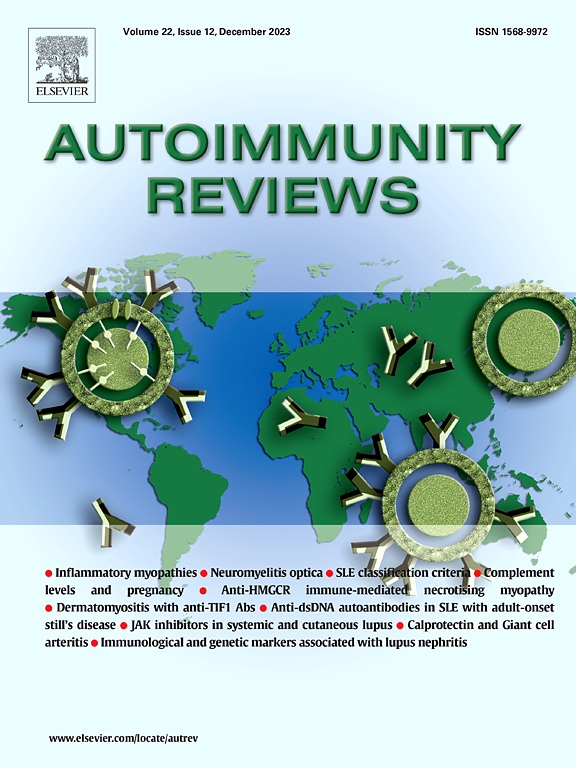寡克隆带和无kappa轻链:竞争参数还是互补的生物标志物?
IF 9.2
1区 医学
Q1 IMMUNOLOGY
引用次数: 0
摘要
背景:2024年修订的多发性硬化症(MS)麦克唐纳标准提出将脑脊液(CSF)特异性寡克隆带和游离kappa轻链(KFLC)作为诊断生物标志物。虽然2017年修订的标准强调了csf特异性寡克隆条带,以指示鞘内IgG合成,显着提高了MS的早期诊断,但KFLC已成为额外的标志物。现在的问题是,这两种生物标志物在多发性硬化症诊断中是作为竞争工具还是互补工具。方法:在这篇叙述性综述中,我们广泛检索了关于脑脊液和血清中寡克隆带和KFLC测定的文献,重点是MS,使用PubMed数据库来证明这两种生物标志物的互补性。结果:寡克隆条带长期以来一直是MS鞘内IgG合成的可靠标记,因其高诊断敏感性、独特的患者“指纹”、克隆分化、半定量分析和分析前稳健性而受到重视。然而,它们在标准化、劳动强度、方法可变性、审查员依赖性和非igg免疫球蛋白数据有限等方面存在挑战。定量测量KFLC提供了对所有免疫球蛋白类别的快速、独立于检查员和成本效益的评估,但可能具有较低的特异性,近年来在标准化解释上缺乏共识,并且尚未得到关于其预后作用的综合前瞻性多国研究的支持。结论:寡克隆条带和KFLC都具有独特的优势和局限性,可以相互补充,有可能作为MS诊断中评估鞘内Ig合成的补充标记。需要进一步的证据来确定KFLC在MS诊断中的价值,因此正在进行多中心前瞻性研究来比较这两种标志物的诊断效用。本文章由计算机程序翻译,如有差异,请以英文原文为准。
Oligoclonal bands and kappa free light chains: Competing parameters or complementary biomarkers?
Background
The 2024-revised McDonald criteria for multiple sclerosis (MS) proposed to incorporate cerebrospinal fluid (CSF)-specific oligoclonal bands and kappa free light chains (KFLC) as diagnostic biomarkers. While the 2017-revised criteria highlighted CSF-specific oligoclonal bands to indicate intrathecal IgG synthesis, significantly enhancing early MS diagnosis, KFLC have emerged as additional marker. Now, the question rises of whether both biomarkers serve as competing or complementary tools in MS diagnostics.
Methods
In this narrative review, we extensively searched the literature on oligoclonal bands and KFLC determination in CSF and serum across neurological disorders, with a focus on MS, using the PubMed database to demonstrate the complementarity of both biomarkers.
Results
Oligoclonal bands have long been a reliable marker of intrathecal IgG synthesis in MS, valued for their high diagnostic sensitivity, unique patient “fingerprints,” clonality differentiation, semi-quantitative analysis, and pre-analytic robustness. However, they present challenges in standardization, labor-intensity, method variability, examiner dependency, and limited data on non-IgG immunoglobulins. Quantitative KFLC measurement provides rapid, examiner-independent, and cost-effective assessment across all immunoglobulin classes but might have lower specificity, lacked consensus on standardized interpretation in recent years, and is not yet supported by comprehensive prospective multinational studies on its prognostic role.
Conclusion
Both oligoclonal bands and KFLC have unique strengths and limitations that complement each other, potentially serving as complementary markers for evaluating intrathecal Ig synthesis in MS diagnosis. Further evidence is needed to establish the value of KFLC in MS diagnosis, thus multicenter prospective studies are being conducted to compare the diagnostic utility of both markers.
求助全文
通过发布文献求助,成功后即可免费获取论文全文。
去求助
来源期刊

Autoimmunity reviews
医学-免疫学
CiteScore
24.70
自引率
4.40%
发文量
164
审稿时长
21 days
期刊介绍:
Autoimmunity Reviews is a publication that features up-to-date, structured reviews on various topics in the field of autoimmunity. These reviews are written by renowned experts and include demonstrative illustrations and tables. Each article will have a clear "take-home" message for readers.
The selection of articles is primarily done by the Editors-in-Chief, based on recommendations from the international Editorial Board. The topics covered in the articles span all areas of autoimmunology, aiming to bridge the gap between basic and clinical sciences.
In terms of content, the contributions in basic sciences delve into the pathophysiology and mechanisms of autoimmune disorders, as well as genomics and proteomics. On the other hand, clinical contributions focus on diseases related to autoimmunity, novel therapies, and clinical associations.
Autoimmunity Reviews is internationally recognized, and its articles are indexed and abstracted in prestigious databases such as PubMed/Medline, Science Citation Index Expanded, Biosciences Information Services, and Chemical Abstracts.
 求助内容:
求助内容: 应助结果提醒方式:
应助结果提醒方式:


